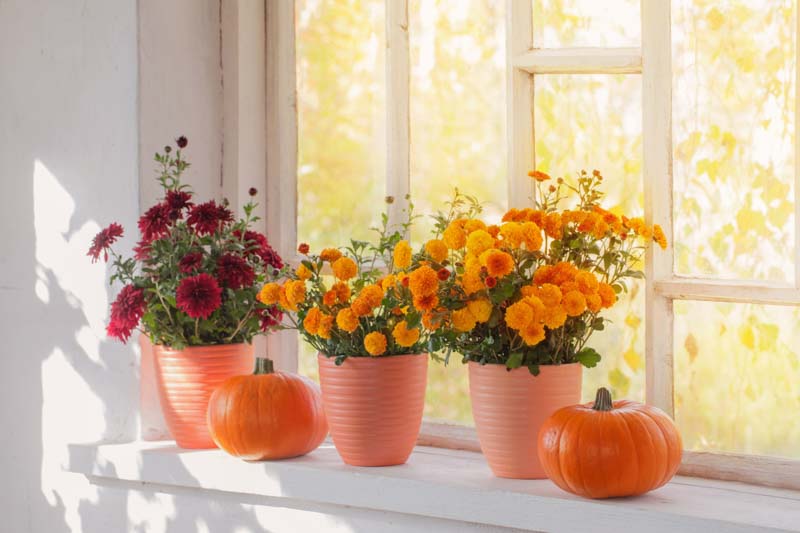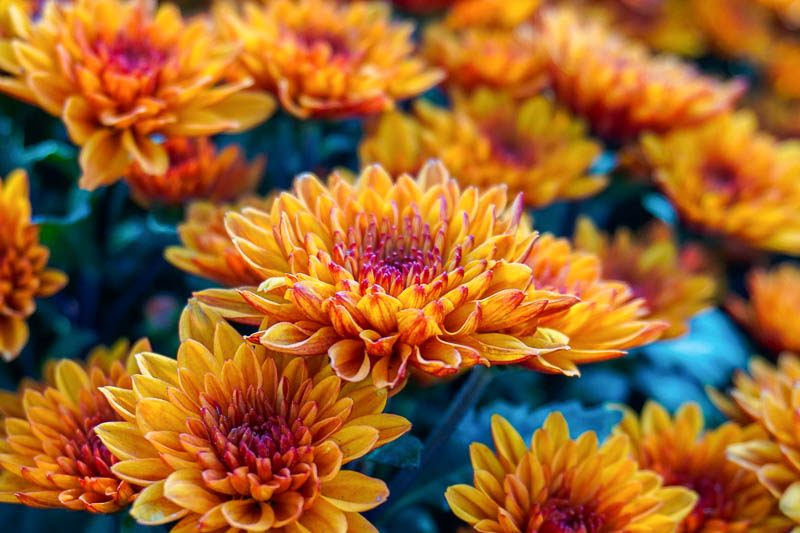Garden Mum, Hardy Garden Mum, Florist's Mum, Florist's Chrysanthemum
Chrysanthemum × morifolium, commonly known as the florist’s chrysanthemum or garden mum, is a perennial plant known for its richly colored blooms and diverse varieties. Originating from Asia, this plant has a long history of cultivation, dating back to the 15th century BC in China, and has since become a staple in gardens and floral arrangements worldwide.
Chrysanthemum × morifolium boasts many flower forms, including pompon, spider, single, and anemone types. The flowers come in various colors, such as white, yellow, pink, and red, making them highly versatile for decorative purposes.
Native: This species is native to Asia, specifically China, where it has been cultivated for over 3,000 years. It was later introduced to Japan and other parts of the world, symbolizing autumn and the changing seasons. The Chrysanthemum belongs to the Asteraceae family, including daisies and sunflowers.
Plant Type and Habit: Garden Mums are herbaceous perennials that form a bushy clump. They feature deeply lobed leaves and a mounding habit, making them ideal for borders and container plantings.
Size: The size of the plant can vary widely among cultivars, typically ranging from 1 to 3 feet (30-90 cm) in height and spread.
Flower: Its flowers are known for their vibrant colors and various forms, blooming profusely from late summer to fall. The blooms can last for several weeks, providing extended color in the garden.
Foliage: The foliage of Chrysanthemum × morifolium is dark green, with deeply lobed leaves that can add texture to the garden even when the plant is not in bloom.
Hardiness: This plant is hardy in USDA zones 5 through 9, although hardiness can vary among cultivars.
Uses: Chrysanthemums are extensively used in landscaping for borders and containers, as well as cut flowers due to their long vase life. They are also celebrated in festivals and shows dedicated to this specific flower.
Pollinators: Chrysanthemums attract various pollinators, including bees and butterflies, making them beneficial for supporting local ecosystems.
Toxicity: Chrysanthemum × morifolium is toxic to dogs, cats, and horses if ingested, causing symptoms like vomiting, diarrhea, hypersalivation, incoordination, and dermatitis.
Deer and Rabbits: Chrysanthemums can appeal to deer and rabbits in many areas.
Benefits: Besides their aesthetic appeal, Chrysanthemums can help improve air quality. They have been found to reduce indoor air pollutants such as ammonia, benzene, and formaldehyde.
Fun Facts: Chrysanthemums are the November birth flower and symbolize loyalty and honesty. They play a significant role in cultural festivals in Asia, particularly the Chrysanthemum Festival (Kiku no Sekku) in Japan. They have been used in traditional Chinese medicine for centuries.

Growing chrysanthemums can be rewarding as they bring vibrant colors to the garden, especially in the fall when many other plants are winding down. Here’s a comprehensive guide to growing these beautiful blooms:
Light: Choose a location that receives at least 5-6 hours of sunlight daily. Mums thrive in well-drained soil, so avoid areas where water stands.
Soil Preparation: Chrysanthemums prefer well-drained, sandy loam with a neutral to slightly acidic soil pH (6.5 to 7.0). If your soil is clayey, amend it with compost or peat moss to improve drainage.
Planting: If starting with a potted plant, dig a hole twice as wide as the pot and of the same depth. Remove the plant from the pot, gently loosen its roots, and place it in the hole, filling it with soil. Water thoroughly.
Watering: Mums require frequent watering due to their shallow roots. However, avoid overhead watering as this can lead to fungal diseases. Instead, water at the base of the plant.
Fertilizing: Mums are heavy feeders. They respond well to adding one or two light applications of a balanced fertilizer such as 10-10-10.
Pinching for Bushier Plants: Pinch off the tips of the stems when the plant reaches 6-8 inches tall (15-20 cm) to encourage branching. This results in a bushier plant with more flowers. Stop pinching around mid-July to allow buds to form.
Deadheading: Remove spent blooms to keep the plant tidy and encourage further flowering.
Protection: While garden mums are cold-hardy, they benefit from mulching for winter protection. Once the ground freezes, add several inches of straw or shredded leaves over the plants.
Overwintering: For perennial varieties, after the first hard frost, cut stems back to 3-4 inches (7-10 cm) above the ground. Mulch over the plants to protect them from freezing and thawing cycles.
Propagation: Chrysanthemums can be propagated by division in the spring. Dig up the plant, divide it into smaller sections ensuring each section has roots, and replant.

Chrysanthemums are beloved for their vibrant blooms, but like all plants, they can encounter pests, diseases, and other growing challenges.
Aphids: These small, sap-sucking insects can weaken plants by feeding on the undersides of leaves. They can also spread viruses. Control them by rinsing with water, using insecticidal soap, or introducing natural predators like ladybugs.
Spider Mites: These tiny pests cause yellowing and stippling on leaves. Increase humidity around the plants or use miticides as needed.
Leafminers: The larvae tunnel inside leaves, creating distinctive trails. Remove affected foliage to reduce their population.
Whiteflies: These white, winged insects feed on plant sap and excrete sticky honeydew. Use sticky traps and insecticidal soaps for control.
Capsid bugs: These pests pierce plant tissues, causing distorted growth, particularly on young shoots and flowers. Control includes removing weeds that host these bugs and applying insecticides early in the season when damage signs appear.
Earwigs: Recognized by their pincer-like appendages, earwigs feed on leaves and petals, creating irregular holes. Management involves trapping them using rolled-up newspapers or shallow containers filled with oil.
Tarnished plant bugs: These insects feed on plant sap, leading to stunted growth and distorted flowers. Keeping the garden clean and using insecticidal soaps or pyrethrin-based insecticides can help control their population.
Thrips: Tiny pests that cause discoloration and streaking on leaves and petals. Thrips can be managed by reducing plant stress, using reflective mulches, and applying appropriate insecticides or predatory insects like lacewings.
Powdery mildew: Appears as a white, powdery coating on leaves and stems. Ensure good air circulation, avoid overhead watering, and use fungicides if necessary.
Chrysanthemum white rust: A fungal disease causing white, pustule-like spots on undersides of leaves and sometimes on flowers. Control with good sanitation, fungicides, and by removing infected plant parts promptly to prevent spread.
Botrytis blight: Affects leaves, stems, and flowers, especially in damp conditions. Improve air circulation and sanitation, and apply appropriate fungicides when needed.
Verticillium wilt: A soil-borne fungus that causes wilting and death of the plant. Plant resistant varieties and ensure good soil health.
Aster yellows: A disease caused by phytoplasma, transmitted by leafhoppers, leading to yellowing leaves, stunted growth, and deformed flowers. Control leafhoppers and remove affected plants to prevent spread.
Fusarium wilt: A fungal disease that blocks water movement in plants, causing wilting and yellowing of leaves. Prevent by ensuring good drainage, avoiding water stress, and using disease-free planting material.
southern blight: This soil-borne fungus causes rot at the base of the stem, leading to plant collapse. Improve soil health, avoid overcrowding, and apply fungicides if necessary for control.
Leggy Growth: Insufficient light can cause plants to stretch. Ensure chrysanthemums receive enough sunlight or supplement with grow lights.
Failure to Bloom: Over-fertilization, especially with nitrogen-rich fertilizers, can lead to lush foliage at the expense of flowers. Adjust your feeding regimen to encourage blooming.
Root Rot: Caused by overwatering or poor drainage. Ensure pots have drainage holes and the soil is well-draining.
| Hardiness |
5 - 9 |
|---|---|
| Heat Zones |
5 - 9 |
| Climate Zones | 2, 2A, 2B, 3, 3A, 3B, 4, 5, 6, 7, 8, 9, 10, 11, 12, 13, 14, 15, 16, 17, 18, 19, 20, 21, 22, 23, 24 |
| Plant Type | Perennials |
| Plant Family | Compositae |
| Genus | Chrysanthemum |
| Common names | Chrysanthemum, Garden Mum |
| Exposure | Full Sun |
| Season of Interest |
Summer (Late) Fall |
| Height |
1' - 3' (30cm - 90cm) |
| Spread |
1' - 3' (30cm - 90cm) |
| Spacing |
12" - 36" (30cm - 90cm) |
| Maintenance | Average |
| Water Needs | Average |
| Soil Type | Clay, Loam, Sand |
| Soil pH | Acid, Alkaline, Neutral |
| Soil Drainage | Moist but Well-Drained |
| Characteristics | Cut Flowers, Showy |
| Attracts | Butterflies |
| Garden Uses | Beds And Borders |
| Garden Styles | Traditional Garden, Informal and Cottage, City and Courtyard |
| Hardiness |
5 - 9 |
|---|---|
| Heat Zones |
5 - 9 |
| Climate Zones | 2, 2A, 2B, 3, 3A, 3B, 4, 5, 6, 7, 8, 9, 10, 11, 12, 13, 14, 15, 16, 17, 18, 19, 20, 21, 22, 23, 24 |
| Plant Type | Perennials |
| Plant Family | Compositae |
| Genus | Chrysanthemum |
| Common names | Chrysanthemum, Garden Mum |
| Exposure | Full Sun |
| Season of Interest |
Summer (Late) Fall |
| Height |
1' - 3' (30cm - 90cm) |
| Spread |
1' - 3' (30cm - 90cm) |
| Spacing |
12" - 36" (30cm - 90cm) |
| Maintenance | Average |
| Water Needs | Average |
| Soil Type | Clay, Loam, Sand |
| Soil pH | Acid, Alkaline, Neutral |
| Soil Drainage | Moist but Well-Drained |
| Characteristics | Cut Flowers, Showy |
| Attracts | Butterflies |
| Garden Uses | Beds And Borders |
| Garden Styles | Traditional Garden, Informal and Cottage, City and Courtyard |
How many Chrysanthemum × morifolium (Garden Mum) do I need for my garden?
| Plant | Quantity | |
|---|---|---|
| Chrysanthemum × morifolium (Garden Mum) | N/A | Buy Plants |
Create a membership account to save your garden designs and to view them on any device.
Becoming a contributing member of Gardenia is easy and can be done in just a few minutes. If you provide us with your name, email address and the payment of a modest $25 annual membership fee, you will become a full member, enabling you to design and save up to 25 of your garden design ideas.
Join now and start creating your dream garden!
Create a membership account to save your garden designs and to view them on any device.
Becoming a contributing member of Gardenia is easy and can be done in just a few minutes. If you provide us with your name, email address and the payment of a modest $25 annual membership fee, you will become a full member, enabling you to design and save up to 25 of your garden design ideas.
Join now and start creating your dream garden!